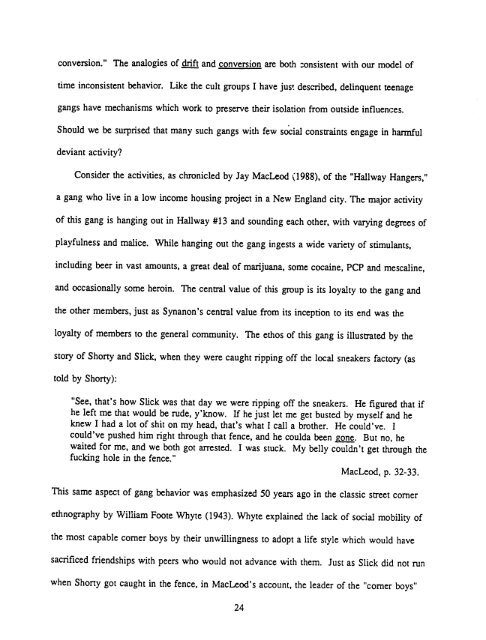INSTITUTE FOR
INSTITUTE FOR
INSTITUTE FOR
You also want an ePaper? Increase the reach of your titles
YUMPU automatically turns print PDFs into web optimized ePapers that Google loves.
conversion." The analogies of drift and conversion are both :onsistent with our model of<br />
time inconsistent behavior. Like the cult groups I have just described, delinquent teenage<br />
gangs have mechanisms which work to preserve their isolation from outside influences.<br />
Should we be surprised that many such gangs with few social constraints engage in harmful<br />
deviant activity?<br />
Consider the activities, as chronicled by Jay MacLeod (1988), of the "Hallway Hangers,"<br />
a gang who live in a low income housing project in a New England city. The major activity<br />
of this gang is hanging out in Hallway #13 and sounding each other, with varying degrees of<br />
playfulness and malice. While hanging out the gang ingests a wide variety of stimulants,<br />
including beer in vast amounts, a great deal of marijuana, some cocaine, PCP and mescaline,<br />
and occasionally some heroin. The central value of this group is its loyalty to the gang and<br />
the other members, just as Synanon's central value from its inception to its end was the<br />
loyalty of members to the general community. The ethos of this gang is illustrated by the<br />
story of Shorty and Slick, when they were caught ripping off the local sneakers factory (as<br />
told by Shorty):<br />
"See, that's how Slick was that day we were ripping off the sneakers. He figured that if<br />
he left me that would be rude, y'know. If he just let me get busted by myself and he<br />
knew I had a lot of shit on my head, that's what I call a brother. He could've. I<br />
could've pushed him right through that fence, and he coulda been gone. But no, he<br />
waited for me, and we both got arrested. I was stuck. My belly couldn't get through the<br />
fucking hole in the fence."<br />
MacLeod, p. 32-33.<br />
This same aspect of gang behavior was emphasized 50 years ago in the classic street comer<br />
ethnography by William Foote Whyte (1943). Whyte explained the lack of social mobility of<br />
the most capable comer boys by their unwillingness to adopt a life style which would have<br />
sacrificed friendships with peers who would not advance with them. Just as Slick did not run<br />
when Shorty got caught in the fence, in MacLeod's account, the leader of the "comer boys"<br />
24

















